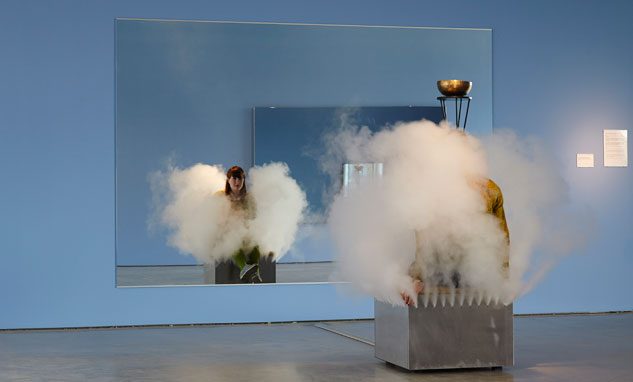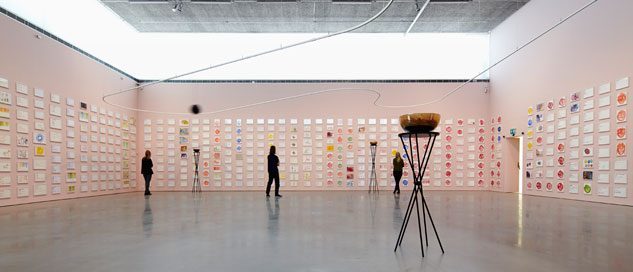Danish artist Jeppe Hein’s installations and sculptures play with our sensory experiences and let the audience take an active role. When visitors approach what may seem to be a familiar thing, like a mirror, they encounter something unexpected. In Light Pavilion a person peddling on a stationary bicycle activates the unfolding of a bright trail of lights into a circus tent. In You everyone trying to look through a hole in the wall meets a reflection of his own eye.
I would like to think that happiness looks like that whale, that it’s always swimming around under the surface, and now and then it looks up and becomes visible.
Answer to: Happiness – What does it look like?
Jeppe Hein’s work rests on a humble anti-hierarchical approach with an open door to Western art history as well as other traditions. Within his work, Hein makes references to minimalism and its use of industrial materials and space, as well as the importance of the viewer for completion of the work. In this exhibition, there are also clear influences of Eastern culture, such as meditation, yoga and Zen Buddhism, which are apparent in the new works Hein has created specifically for the gallery. Visitors entering the gallery will release hanging balls that run a dynamic track passing different singing bowls that start to sound whenever a ball touches them, thus creating a vibrating soundscape.
In A Smile for You, Bonniers Konsthall takes a larger grip on Jeppe Hein’s oeuvre. Hundreds of watercolors hang in the exhibition center, painted by Jeppe Hein at a time when he was burned out. They are a form of diary in which the viewer can follow the artist from a deep state of depression to the first signs of recovery. The vulnerability found in the paintings alters the reading of the exhibition as a whole, and also presents a decisive shift in Jeppe Hein’s practice.
Some works will appeal to the visitor’s senses; others will demand their active involvement. Some will create a funny situation engaging people to start a dialogue with each other; others will face the viewer with essential questions that they can only answer on their own. All of them will offer people a moment of being “right here right now“ and a smile on the face.
Jeppe Hein
The exhibition A Smile for You is part of a larger collaboration between the artist Jeppe Hein, Bonniers Konsthall and Wanås Art. In a poster campaign, Jeppe Hein asks the public questions such as ‘what is happiness to you?’ and ‘how does it smell, taste, and feel?’. A selection of answers will be presented in the exhibitions at Bonniers Konsthall and Wanås Art. The collaboration also includes a joint publication, published by Walther König Verlag.
Program
Wednesday April 24th, 5 pm. Artist talk with Jeppe Hein.
The artist talk is postponed due to illness
Danish artist Jeppe Hein’s installations and sculptures play with our sensory experiences and let the audience take an active role. In this artist talk, you will hear Jeppe Hein himself talk about his art and the works we show at Bonniers Konsthall. The talk will be held in English.
Wednesday, May 8th, 6 pm, Kay Larson: Why was John Cage happy?
Welcome to this lecture when Kay Larson, art critic, columnist and editor, will talk about the composer John Cage’s relationship to happiness. The lecture is part of the program of Jeppe Hein’s exhibition and new work of art that is based on the artist’s desire to understand what happiness is. Both Cage and Hein are inspired by Zen Buddhism, and one can find influences of Eastern tradition in both their artistry.
John Cage, “one of the most influential composers in modern history” (as he has been called), was also one of the happiest. The story of how Cage found happiness – and used it to create new forms of music and art – offers a useful and original way of describing profound shifts in the cultural history of the last half-century. Cage learned from Zen Buddhism that there is no “gap” between art and life. In fact, there is no gap anywhere. Nothing separates us from others, or from the consequences of our actions. By asking spiritual questions and finding answers, Cage constructed an active happiness that opened his heart, mind and arms to others.
Kay Larson is the former art critic of New York Magazine (1980 – 1994) and was a frequent contributor to the New York Times (1995 – 2005). She is author of the book Where the Heart Beats: John Cage, Zen Buddhism, and the Inner Life of Artists (Penguin Press, July, 2012) and a practicing Buddhist.
Wednesday, May 29, at 6 pm, Jeppe Hein according Psykologer tittar på konst
Jonas Mosskin, psychologist and one of the organizers behind Psykologer tittar på (Psychologists looking at…) is back at Bonniers Konsthall after his appriciated guidance of Klara Kristalovas exhibition spring 2012. Jonas Mosskin will take visitors on a personal tour of the exhibition A Smile for You. He approaches Jeppe Hein’s new work on fatigue and happiness from a psychologist’s perspective and connects what he sees to creation and creativity.
Workshop: Learn to paint with Buddhist singing bowls
One can find traces of Eastern traditions in Jeppe Hein’s art. For the exhibition A Smile for You, he has created a new work where hanging balls knock against an installation of Buddhist singing bowls, creating a vibrating soundscape. The artist has also developed a technique to paint with these meditation bowls by using the vibrations generated by touch. In this workshop, you will have the possibility to try out the technique.
At 11-15 selected Sundays: 28 april, 5 May, 19 May, 26 May, 16 June, 30 June, 14 July, 28 July. The workshop will also take place during the National Day, Thursday June 6th. Suitable from 5 years.
The happiness relay race
Listen to what philosophers, commentators, brain researchers, yoga teachers and advertisers have to say about happiness! During spring and summer Bonniers Konsthall will host a relay race of short 10-minute presentations related to happiness just after our Saturday tours. A new person offers a new perspective every week.
Saturdays, after our Saturday guided tour: 27/4, 11/5, 18/5, 25/5, 1/6, 8/6, 15/6.
With support by the Danish Embassy and Statens Kunstfond

